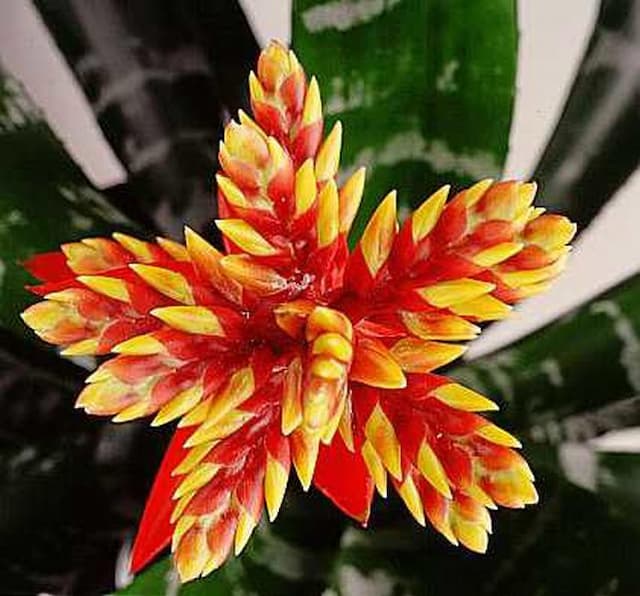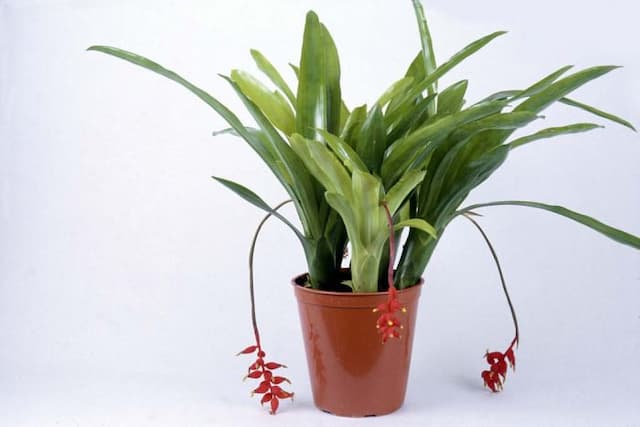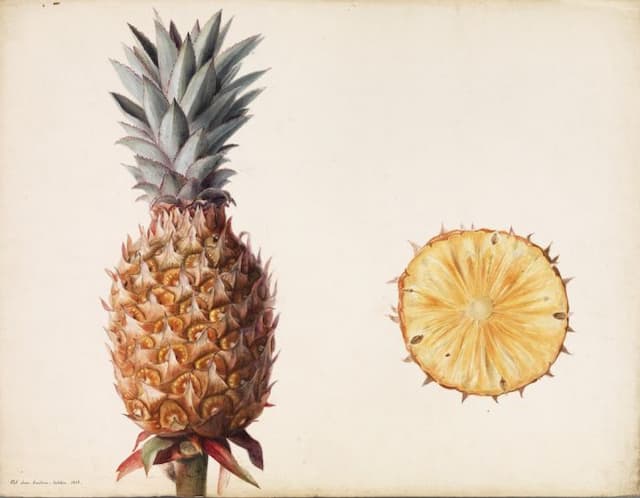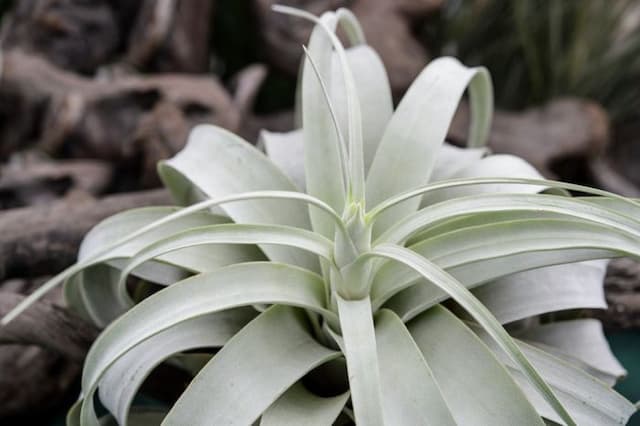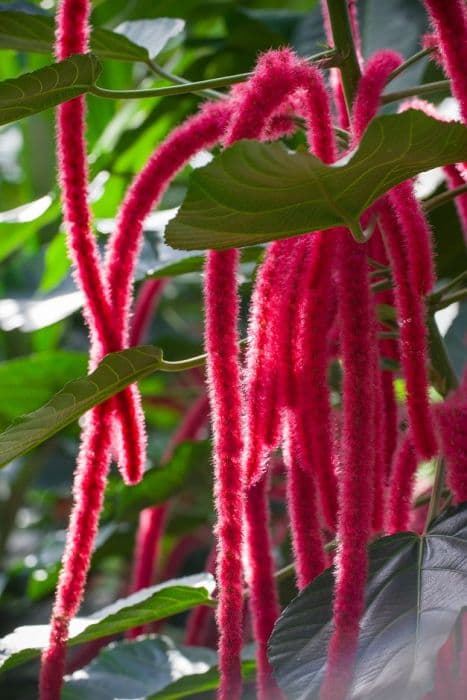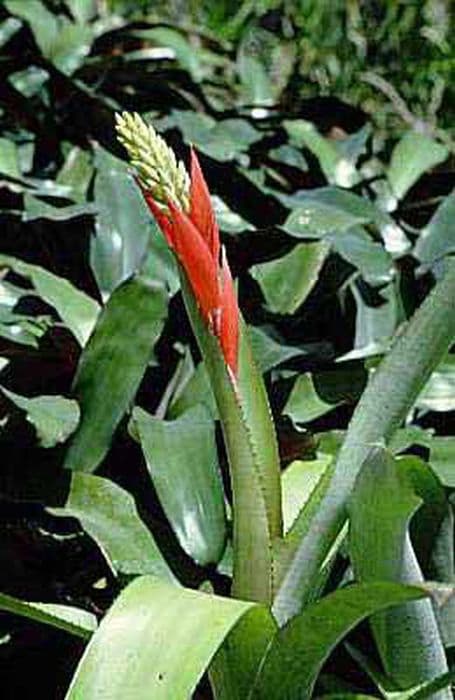Bromeliad Bromeliaceae genera


ABOUT
A bromeliad is a type of tropical plant known for its unique and striking appearance. In terms of size, bromeliads can vary widely, but they typically range from a few inches to several feet in height and width, depending on the specific species and growing conditions.
Smaller bromeliads may have a height of around 6 inches to 1 foot, with a width of 6 inches to 1.5 feet. These are often used as decorative houseplants or in terrariums. Medium-sized bromeliads can reach heights of 1 to 2.5 feet with a similar width, and they are often used in indoor or outdoor landscaping for their ornamental foliage and colorful bracts.
Larger bromeliad species can grow significantly taller, reaching heights of 3 to 5 feet or even more, with a corresponding increase in width. These larger bromeliads are often found in tropical gardens and can make dramatic focal points in the landscape due to their size and vibrant blooms.
About this plant
 Names
NamesFamily
Bromeliaceae
Synonyms
Bromeliad, Bromelia
Common names
Bromeliaceae genera
 Toxicity
ToxicityTo humans
Bromeliads are generally considered non-toxic to humans. They are safe to handle and touch. However, the sap or juice inside the leaves of some bromeliad species can be mildly irritating to the skin, and contact may cause minor skin irritation or dermatitis in some individuals. Ingesting parts of the plant is not recommended, as it can lead to gastrointestinal discomfort, nausea, or vomiting in rare cases. While bromeliads are not typically a significant concern for human toxicity, it's still advisable to avoid ingesting them and to wash your hands after handling them to prevent skin irritation.
To pets
Bromeliads can be toxic to pets, especially cats and dogs, if ingested. The specific compounds responsible for toxicity can vary between different bromeliad species, but they often contain substances that can cause digestive upset, drooling, vomiting, and in some cases, more severe symptoms. Some bromeliads contain calcium oxalate crystals, which can be irritating to the mouth and throat.
 Characteristics
CharacteristicsLife cycle
Perennials
Foliage type
Evergreen
Color of leaves
Green
Flower color
Vary
Height
1 - 5 feet
Spread
1 - 5 feet
Hardiness zones
8
Native area
Central and South America
Benefits
 General Benefits
General BenefitsAesthetic Appeal: Bromeliads come in a wide variety of colors, shapes, and sizes, making them visually attractive additions to gardens, homes, and offices.
Low Maintenance: Bromeliads are relatively easy to care for and require minimal maintenance. They are well-suited for individuals who may not have a green thumb.
Long-lasting Blooms: Bromeliads often have long-lasting, vibrant, and exotic-looking flowers or bracts, making them a stunning focal point in gardens and interiors.
Adaptability: Many bromeliad species are adaptable to various growing conditions, including low light, making them suitable for different indoor environments.
Versatile Use: Bromeliads can be used in a variety of settings, such as flower beds, containers, hanging baskets, and even as epiphytes attached to trees or other structures.
Unique Foliage: Bromeliads are known for their unique foliage, which can feature interesting textures, patterns, and colors, adding visual interest to your surroundings.
Indoor Tropical Feel: Growing bromeliads indoors can create a tropical ambiance and bring a touch of the exotic to your home or office.
Drought Tolerance: Some bromeliad species are drought-tolerant and can withstand dry conditions, making them suitable for xeriscaping and areas with water restrictions.
Decoration: Bromeliad leaves and bracts are often used in floral arrangements and decorative displays due to their unique appearance. Medical Properties
Medical PropertiesBromeliads, particularly certain species like Ananas comosus (pineapple), have been used in traditional medicine for their potential medicinal properties. It's important to note that while some studies suggest potential health benefits, the medical properties of bromeliads are not as extensively researched as those of many other medicinal plants.
 Air-purifying Qualities
Air-purifying QualitiesOxygen Production: Like all green plants, bromeliads undergo photosynthesis, a process in which they take in carbon dioxide and release oxygen. This natural process can increase the oxygen levels in your indoor environment, which can be beneficial for your overall well-being.
Humidity Regulation: Bromeliads release moisture through a process known as transpiration. This can help increase humidity levels in the immediate vicinity of the plant, potentially improving indoor air quality, especially in dry indoor spaces. Adequate humidity can help reduce the negative effects of dry air on respiratory health.
Minimal Toxin Removal: While bromeliads are not as efficient at removing toxins from the air as some other plants, they may still contribute to a modest degree. Like all houseplants, they can help remove small amounts of airborne pollutants, but their effect in this regard is not as significant as dedicated air-purifying plants like snake plants, spider plants, or peace lilies. Other Uses
Other UsesBromeliad Trees: Cluster a variety of bromeliads together on a wooden or metal frame to create a bromeliad tree. This can serve as a captivating centerpiece in your garden or on your patio.
Air Plant Arrangements: As epiphytic plants, some bromeliads, like Tillandsia species, can be mounted on driftwood, shells, or other creative supports to make unique and low-maintenance air plant arrangements.
Living Chandeliers: Combine multiple small bromeliads in a hanging chandelier-like arrangement to create a captivating living light fixture. This can be an eye-catching addition to indoor or outdoor spaces.
Floating Bromeliads: Place bromeliads in a water feature, such as a pond, pool, or decorative fountain, where they can float on the water's surface. This can add a touch of beauty and tranquility to the area.
Bromeliad Bouquets: Incorporate bromeliads into cut flower arrangements or bouquets to add exotic and colorful elements to your floral displays.
Wedding Decor: Use bromeliads as unique and long-lasting wedding decor, such as centerpieces, boutonnieres, or bouquets, adding a tropical flair to the celebration.
Living Jewelry: Small bromeliads, particularly air plants, can be incorporated into living jewelry, such as pendants, bracelets, or hair accessories, for a distinctive and natural look.
Tabletop Centerpieces: Feature bromeliads as tabletop centerpieces in decorative containers, like glass terrariums or unusual containers like hollowed-out tree trunks or seashells, for a conversation-starting display.
Bromeliad Art Installations: Create temporary or permanent art installations using bromeliads. They can be arranged in artistic patterns, designs, or sculptures to transform spaces into living works of art.
Interesting Facts
 Feng Shui
Feng ShuiIn Feng Shui, the principles of using plants like bromeliads focus on promoting positive energy, balance, and harmony within the environment. Here are some tips on using bromeliads in Feng Shui:
Placement: Place bromeliads in areas that need a boost of energy, color, or vitality. They are often associated with the Fire element, making them suitable for the Fame and Reputation area (the southern part of a room or space) and the Career area (the northern part). Their vibrant colors can also add vibrancy to the Wealth and Abundance area (southeast).
Color Selection: Choose bromeliads with colors that correspond to the specific Feng Shui area. For example, red and pink bromeliads can enhance the Fame and Reputation sector, while green or purple varieties can be suitable for the Wealth and Abundance area.
Balance and Care: Maintain balance and harmony by placing bromeliads alongside other complementary elements. Avoid overcrowding or overwhelming a space with too many plants.
Healthy Growth: Keep your bromeliads healthy and vibrant as sick or dying plants can bring negative energy. Regularly care for them by ensuring proper light, water, and temperature conditions.
Display: Use decorative containers or pots that align with your desired Feng Shui aesthetics. Round or oval pots are often recommended for creating a balanced energy flow. Zodiac Sign Compitability
Zodiac Sign CompitabilityIn astrology, plants like bromeliads are not typically associated with specific zodiac signs
 Plant Symbolism
Plant SymbolismBromeliads do not have as rich a history of symbolism as some other plants and flowers
 Water
WaterBromeliads have unique watering requirements. They don't rely on their roots for water absorption as much as other plants do. Instead, they collect water in their central rosettes, known as the "tank." Here's how to water a bromeliad:
Water in the Central Tank: Fill the central tank of the bromeliad with water, ideally using non-chlorinated water (rainwater or filtered water is best). Avoid filling the tank to the brim, but ensure it has enough water to keep it moist. Change the water in the tank regularly to prevent stagnation.
Avoid Overwatering the Soil: While the central tank should be kept moist, you should avoid overwatering the soil. Only water the soil when it is completely dry. Typically, this might be once every 2-4 weeks, depending on environmental conditions.
Mist the Foliage: Bromeliads benefit from occasional misting, especially in drier indoor environments. Use a spray bottle to lightly mist the foliage to provide additional humidity. Light
LightBromeliads prefer bright, indirect light. Here are some guidelines for their light requirements:
Indoors: Place your bromeliad near a window with filtered sunlight. Avoid direct sun exposure, which can scorch the leaves. East or west-facing windows are often suitable.
Outdoors: In gardens or outdoor settings, choose a location with dappled or filtered sunlight, such as under the canopy of taller plants or trees. Some varieties can tolerate more sunlight but may require acclimatization. Temperature
TemperatureBromeliads come from tropical and subtropical regions and prefer temperatures within a certain range:
Temperature Range: Bromeliads thrive in temperatures between 60°F to 80°F (15°C to 27°C). They are sensitive to cold and cannot withstand frost.
Indoor Environment: Maintain room temperatures within the recommended range. Avoid placing bromeliads near drafts or close to air conditioning vents, as sudden temperature drops can harm them.
Outdoor Care: If growing bromeliads outdoors, make sure you bring them inside or protect them from frost and extreme cold during the winter months. Pruning
PruningBromeliads generally require minimal pruning. However, you may need to remove old or unsightly foliage to maintain the plant's appearance and health: Remove Dead Leaves: Trim away any dead or brown leaves from the plant using clean, sharp scissors or pruning shears. Be careful not to damage the healthy foliage. Pup Removal: When bromeliads produce offsets or "pups" at the base, they can be separated from the parent plant once they are a reasonable size and have developed their own roots and roots. Flower Removal: After a bromeliad's flower has faded, you can trim the spent flower spike to encourage new growth. Cut the flower spike back to the base of the plant.
 Cleaning
CleaningAs needed
 Soil
SoilBromeliads are typically epiphytic or epilithic, meaning they don't rely on soil for nutrients in the same way as terrestrial plants. Instead, they obtain most of their nutrients and moisture from the air and rainwater through their tank-like central rosettes. However, when you're growing bromeliads in pots or containers, it's important to provide a suitable potting mix. The best potting mix for bromeliads is an epiphytic or well-draining mix. Here's what you can use:
Bromeliad Mix: You can purchase a specialized bromeliad or orchid mix, which is specifically designed to mimic their natural epiphytic or lithophytic growing conditions. These mixes often contain materials like bark, perlite, and sphagnum moss.
Make Your Mix: Alternatively, you can create your own mix by combining materials like orchid bark, perlite, sphagnum moss, and a small amount of potting soil to improve water retention. Repotting
RepottingBromeliads don't require frequent repotting, as they are relatively slow-growing plants. You may need to repot them when:
Overcrowding: If offsets (pups) have grown and crowded the parent plant, it's a good time to consider repotting the pups into their own containers.
Deteriorating Mix: If the potting mix has broken down, become compacted, or is no longer draining well, it may be time to repot the bromeliad into fresh mix.
Root Health: Inspect the roots during repotting. If they are rotting or damaged, trim away the affected parts and repot the plant into fresh mix. Humidity & Misting
Humidity & MistingBromeliads, especially tropical species, thrive in humid conditions. The ideal humidity level for bromeliads is around 50% to 60% or higher. To maintain suitable humidity for your bromeliads:
Misting: Regularly mist the foliage of your bromeliads to increase humidity around the plant. Use a spray bottle to provide a fine mist.
Humidifiers: If you're growing bromeliads indoors and your home has low humidity, consider using a room humidifier to raise the humidity level around your plants.
Grouping: Grouping your bromeliads together can create a microclimate with increased humidity, as the plants release moisture through transpiration.
Trays of Water: Placing trays of water near your bromeliads, especially during dry seasons, can help increase local humidity levels. Suitable locations
Suitable locationsIndoor
Bright, indirect light, water in central tank, well-draining soil. Keep humidity up
Outdoor
Filtered sunlight, well-drained soil, regular watering, frost protection as needed
Hardiness zone
10-11 USDA
 Life cycle
Life cyclePropagation:
Bromeliads can be propagated from seeds, offsets (pups), or occasionally from cuttings. The duration of this stage can vary widely depending on the method of propagation and the species. From seeds, it may take several months for germination to occur. Pups can take a year or more to develop into independent plants.
Growth:
The growth phase is characterized by the development of the plant's foliage and the central tank. The duration of this stage varies depending on the species and growing conditions. Some bromeliads can take several years to reach maturity, while others may mature more quickly.Vegetative Stage:
During this stage, the bromeliad focuses on producing leaves, building up its central tank, and developing a robust root system. The exact duration of the vegetative stage depends on factors like light, temperature, and care.Flowering:
The timing of flowering varies greatly between different bromeliad species. Some may take several years to reach the flowering stage, while others can flower in as little as 1-2 years. Generally, bromeliads are known for their long-lasting and striking blooms, which can persist for several months.Fruit Formation:
After flowering, the bromeliad may produce fruit, which typically contains seeds. The duration of this stage can vary depending on the species, but it usually takes a few months for the fruit to fully develop.Seed Maturation:
If your bromeliad produces seeds, the time it takes for them to mature within the fruit can vary. Typically, it takes several months for bromeliad seeds to become fully mature.Harvest:
If you are growing bromeliads for their seeds, you can harvest the seeds once they are mature. The timing of the harvest will depend on when the seeds are ready. For other types of bromeliads, such as those grown for ornamental purposes, there may not be a specific harvest stage.
Reproductive Cycle:
Bromeliads are generally monocarpic, meaning they flower once in their lifetime and then gradually decline. After flowering and fruiting, the plant may continue to produce offsets or pups, starting a new cycle of growth and development. Propogation
PropogationPropogation time
Vary
Bromeliad propagation is typically done through offsets or pups, which are small plantlets that grow at the base of the parent plant. The best time for propagation is usually during the growing season, which is spring and early summer. Here are the steps for propagating bromeliads from offsets:
Wait until the offset is at least one-third the size of the parent plant and has its own roots.
Carefully remove the offset from the parent plant using a clean, sharp knife or shears.
Plant the offset in a suitable potting mix, or mount it on a piece of bark or other suitable support, ensuring it has good contact with the growing medium.
Water the offset sparingly, allowing the roots to establish.
Propagation timing can vary depending on the specific bromeliad species, so it's essential to monitor your plant for the right stage of development before attempting propagation.
 Pests
PestsSpider mite, Thrips, Scale insects, Mealybug, Aphid, Slugs and snails
 Diseases
DiseasesRoot Rot, Powdery mildew, Leaf spot, Rust
